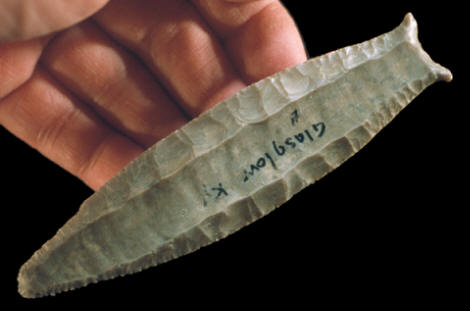|
CUMBERLAND
POINT
PALEO-INDIAN
GLASGOW, KENTUCKY
PRIVATE COLLECTION
COPYRIGHT JANUARY 31, 2008 PETER A. BOSTROM

CLICK ON PICTURE FOR LARGE TRIPLE
IMAGE
ORIGINAL ARTIFACT ILLUSTRATED
CAST
#P-74
CUMBERLAND POINT
PALEO-INDIAN
GLASGOW, KENTUCKY
This Cumberland point is
referred to as the “Grievo Cumberland.” It was recently rediscovered in
an old safe in New Jersey that hadn’t been opened for sixty years. This
is an excellent example of a very rare eastern fluted point type. Its
most interesting feature is the sharpened edges near the point that were
also serrated, an indication that it may also have been used as a knife.
It’s made of either St. Genevieve or Fort Payne chert and measures 4 ¾
inches (12 cm) long, 1 3/16 inches (3 cm) wide and 5/16 inch (8.4 mm)
thick.
Cumberland points are diagnostic of the Paleo-Indian period.
The only carbon date for a Cumberland point comes from the Dutchess
Quarry Cave #1 site in New York. A carbon date taken from a caribou bone
produced a date of 10,580 B.C. + 370. Cumberland points have been
described as being diagnostic of the Parkhill complex in the Great Lakes
area. The Parkhill complex is known for Barnes points, which have a
different shape than Cumberland points. Cumberland points are found in
Kentucky, Tennessee, Alabama and other states in the southeast. |
